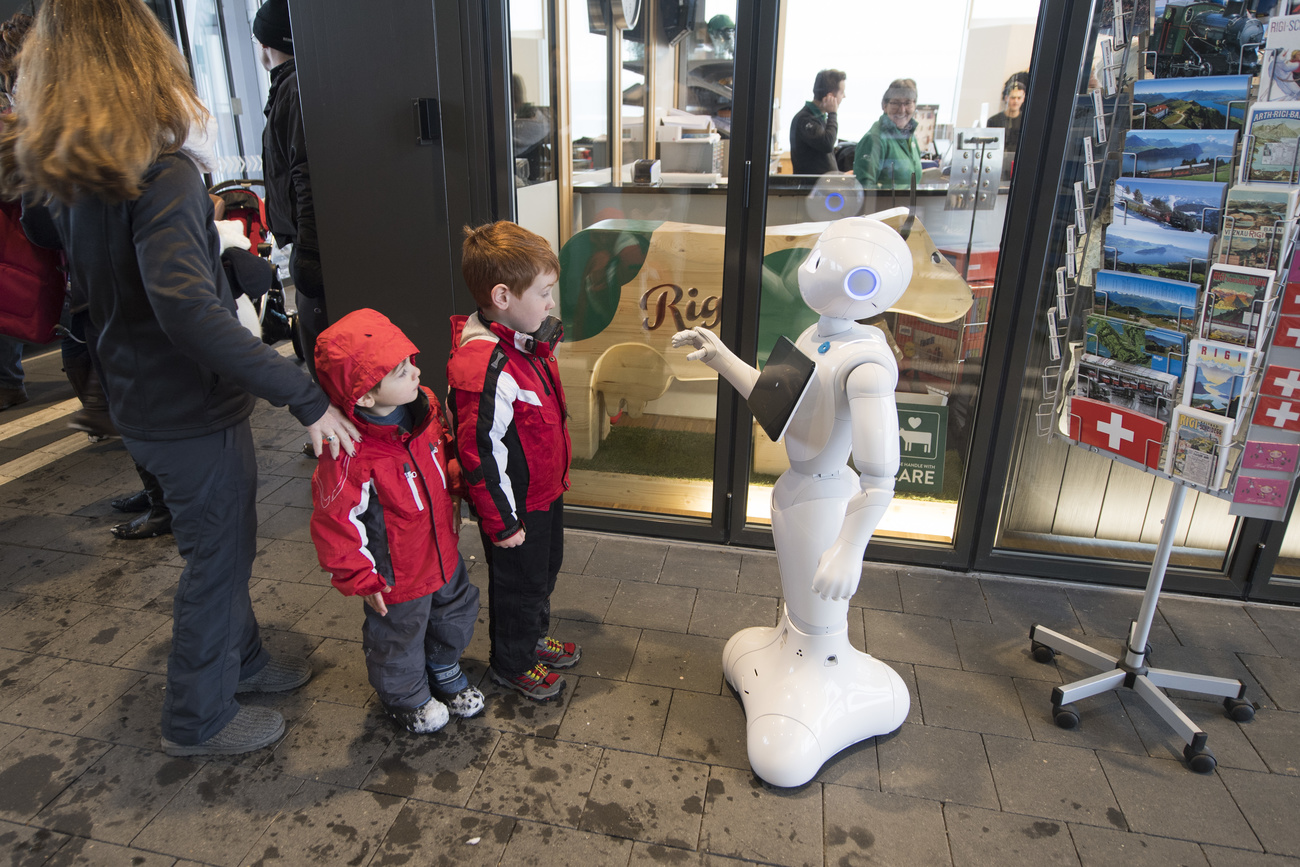
Robots in schools: new teaching methods on the horizon?
The pandemic is forcing us to rethink everything, even how we teach. What if robots are the future of education?
Thymio, Lexi, Elias, Pepper, Nao, Anastasia, Kaspar: they could be your child’s new classmates. They are diligent but not competitive, they know a lot but are not arrogant, they learn from others while helping them to learn. But instead of being flesh-and-blood children, they have a metal heart and an electronic brain. They are robots and are mainly used in education and schools.
According to forecasts, the market for educational robots is set to expand significantly in the coming yearsExternal link. The growing demand for collaborative robots in education and industry could also reverberate in the creation of new jobs.
In addition, the Covid-19 pandemic and school closures could significantly drive the long-term development of the educational robotics market.
But what’s special about these intelligent machines? Robots in schools and universities can act as responsive mentors and assist students and teachers through more interactive teaching that encourages sociability rather than isolation. A robot can become such a developed physical, social and emotional interface that it can read children’s facial expressionsExternal link.
What do you think about this trend? Would you try learning from a robot like this, or want your children to try it? Are you a researcher who’s worked on the question of learning robots? Write me your comments.
(Almost) human robots
For a piece about the future of educational technology, my colleague Christian Raaflaub recently talked about educational robots with Francesco Mondada, co-leader of the Educational Robotics groupExternal link at the National Centre of Competence in Research RoboticsExternal link (NCCR):
“Hi everyone, I’m Lexi”. With these words, a humanoid robot greets students at the University of St Gallen. The interest is great. The classroom is full of people. “Lexi”External link is a robot designed to help students with their research. And then there is “Thymio”,External link a robot that can be programmed at will by the pupils. Various digital technologies are currently invading classrooms and schools.
I spoke to the people behind the development of these robots and asked them about the potential and dangers of teaching and learning tools of this kind. Francesco Mondada, who developed ‘Thymio’, says: “A robot has the potential to disrupt the educational form of traditional teaching and to raise a lot of interest. It can bring a new dynamic to classrooms”.
The robotics professor, however, warns of the danger of too strong an emotional attachment to a humanoid robot, especially among children. Mondada cites an example from the US army: “Soldiers were ready to save the robot at the cost of their or another’s life”.
Read more soon on swissinfo.ch. You can find and bookmark our science and robotics coverage here.

More
Switzerland gears up to place robots in classrooms
Giving voice to research
The NCCR Robotics is a national organisation set up in 2010 and funded by the Swiss National Science FoundationExternal link. It brings together 28 robotics laboratories throughout Switzerland with the aim of developing new human-oriented technologies to improve our quality of life. Educational robotics is one of the centre’s main areas of research.
Starting today, we will be featuring an NCCR researcher in each edition of our newsletter to keep you up to date on what the researchers are working on and give a voice to those behind it.
On the occasion of the International Day of Women and Girls in ScienceExternal link, celebrated every year on 11 February, we talked to young Italian researcher Barbara BrunoExternal link, who works at the Computer-Human Interaction Lab for Learning and InstructionExternal link at the Swiss Federal Institute of Technology Lausanne (EPFL). As part of the NCCR Educational Robotics Grand Challenge, Barbara studies how robots, and interactions with them, can enhance human learning.

SWI swissinfo.ch: Barbara, what personal path led you to the EPFL and to robotics?
Barbara Bruno: One day at school, our math professor taught us the notion of an algorithm. Writing an algorithm means finding a method to solve an entire class of problems, reflecting on the existence of special cases and how to properly handle them, devising experiments to check that a solution truly works. I was fascinated! Later, I enrolled in a degree course in Computer Engineering at the University of Genoa, Italy.
I discovered robotics thanks to my Bachelor thesis: the topic was the indoor localisation of a mobile robot deployed in a hospital. I really liked the contrast between the abstract reasoning required to design solutions, and the very practical evaluation of their effects. As the years passed, I realised that being a roboticist and an academic researcher is my dream job.
Do you think the robotics sector has a gender problem? And if so, what can be done, starting from school, to bridge the gap?
if you ask me whether there are more men or women in my lab (the CHILI labExternal link of prof. Pierre Dillenbourg) I would have to sit down and count: it’s hard to tell at first sight! So while there still is a gender gap in robotics, I think it gets smaller and smaller every day and I am confident that it will be closed soon.
Education is crucial to this aim: school helps children discover their talents and passions, cultivate them, and turn them into fulfilling careers. It is fundamental that robotics be correctly presented to schoolchildren, without false prejudices or stereotypes, so that anyone drawn to it is able to pursue it.
What are the practical issues facing robotics education, teaching and learning today?
As a roboticist, I tend to assume that everything is better with a robot in it. As a researcher, I tend to question everything, and especially everything I say. Why should we want a robot in a classroom? What do we gain from it? What benefits would it bring to students and education?
Educational robots such as “Thymio” and “Cellulo”External link can make visible and tangible (and so, somewhat easier to understand), concepts and phenomena otherwise invisible: the studies of my colleague Laila El Hamamsy, for example, reveal how educational robots such as “Thymio” can be used to foster computational thinking skills at the first levels of primary school.
Another colleague, Hala Khodr, is using “Cellulo” robots to help students understand swarm behaviours, which are ubiquitous in nature and difficult for us to grasp due to our tendency to see a leader and a central organisation behind any complex phenomenon.
Lastly, it is a common experience that having to teach something is one of the best ways to learn it: in the iReCHeCk projectExternal link a social robot is taught how to write by children, who thus practice handwriting with great commitment and no fear of judgment. These examples tell us that the role that robotics can play for learning and education is broader and deeper than one might imagine at first… and therefore, it is even more important for us to do research.
*****
That’s it for this edition of our newsletter; if you don’t yet get this regular Swiss science dispatch in your inbox, sign up below. Do you have thoughts about anything discussed? Let’s talk about it over a (virtual) coffee.

In compliance with the JTI standards
More: SWI swissinfo.ch certified by the Journalism Trust Initiative
















![The four-metre-long painting "Sonntag der Bergbauern" [Sunday of the Mountain Farmers, 1923-24/26] had to be removed by a crane from the German Chancellery in Berlin for the exhibition in Bern.](https://www.swissinfo.ch/content/wp-content/uploads/sites/13/2025/12/01_Pressebild_KirchnerxKirchner.jpg?ver=14ffbad8)















Join the conversation!